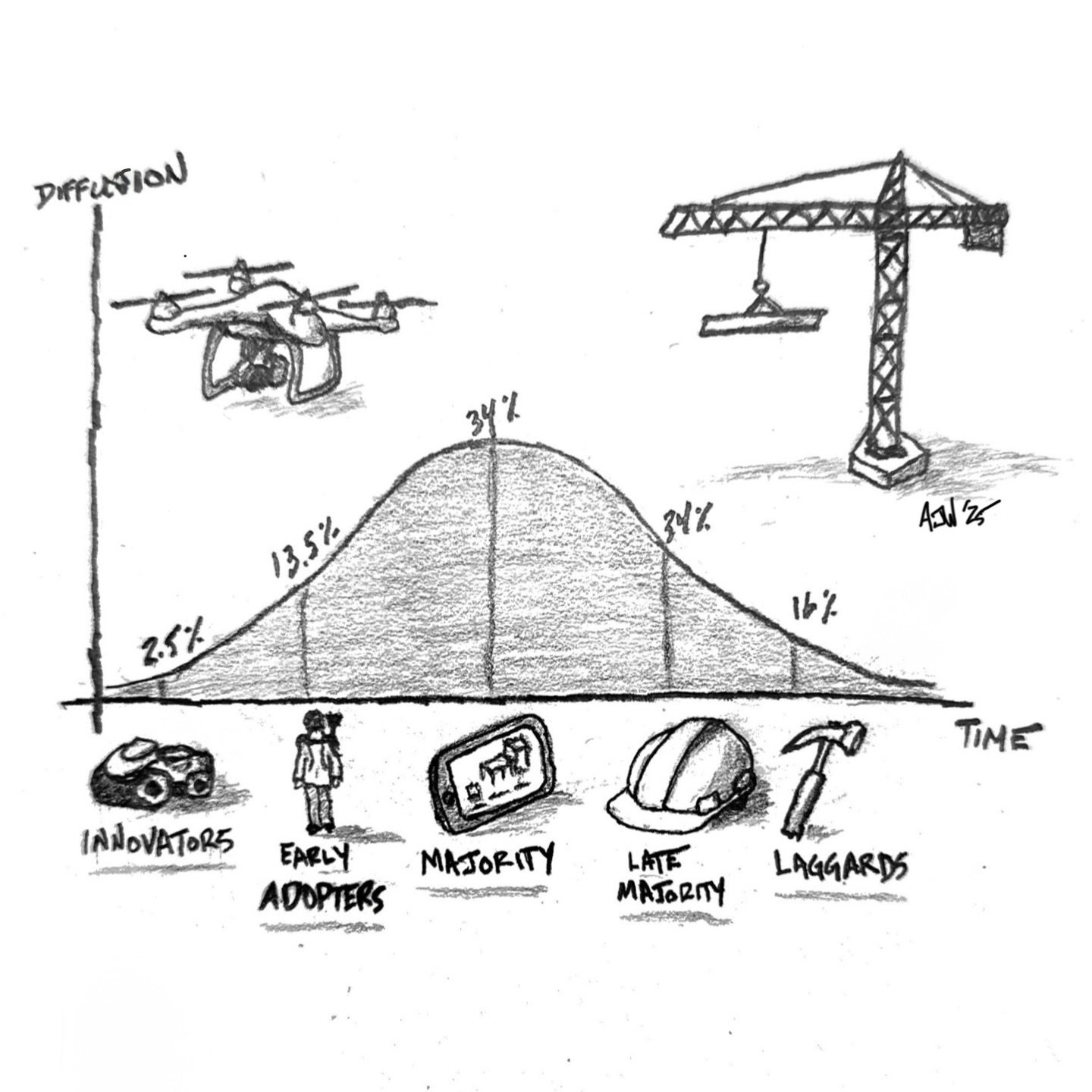Riding the Wave: Why You Want to Be In Front of the Law of Diffusion
There is a popular law that is often cited in the world of technology: the Law of Diffusion of Innovation. It’s the idea that new technologies spread through society in a predictable wave-like pattern. Things start out small with the brave souls known as innovators, begin to grow through early adopters and, after peaking, eventually slow down reaching the laggards (you know who you are, still proudly using that flip phone).
Of course, we’ve all heard how that’s just the way construction in general treats tech, right? This massive, $15+ trillion global industry actively avoids all things shiny and new in technology and quite literally defines the laggard section of the curve.
Well, many in the industry, including myself, are tired of hearing that. So, let’s take a look at how the famously “resistant” construction industry learn from this well-known Law.
Construction's Rocky Relationship with Innovation
While we may all have grown tired of hearing it, there is a reason that construction has the tech-adverse perception that it does. It’s no secret that construction doesn't exactly jump at adopting the latest tech. According to McKinsey, construction consistently ranks near the bottom when it comes to digital transformation. This is real data backing up the fact we lag behind sectors like finance, retail and even agriculture (those good-old Nebraska farmers). Yes that’s right, agriculture—the industry literally built on watching plants grow.
A lot of this hesitation when it comes to tech has to do with how risk is perceived. Construction companies operate on incredibly tight margins and even tighter schedules. Introducing new tech feels less like innovation and more like an all-nighter gambling in Vegas (except less fun and without the buffets).
The Diffusion Curve as it Relates to Construction
If we take a deeper look at the diffusion of innovation curve for construction, breaks down adopters into five groups:
The Innovators (2.5%): These are your tech enthusiasts—construction firms that jump on new software faster than you can say "blockchain."
The Early Adopters (13.5%): Companies that like being ahead but prefer to see someone else take that first step. They proudly show off their drone fleets and automated workflows.
The Early Majority (34%): Pragmatists who are eager to adopt technology once its benefits are clear and proven.
The Late Majority (34%): Skeptics who adopt tech mostly because everyone else already has and they’re losing ground because of it.
The Laggards (16%): Firms who will digitize their punch lists only when their fax machines spontaneously combust.
Unfortunately, construction would historically cling to the right side of that curve. So much so that Deloitte notes construction's slow tech adoption has directly tied to profitability and productivity challenges.
The ultimate irony is that hesitation actually reduces the competitive advantage that technology and innovation can provide.
What Happens When Popular Tech is Over the Hump
This is where things get pretty interesting, though. Many of the industry's favorite tools—platforms that were once considered groundbreaking—have moved beyond their time on the early majority side of the curve and are comfortably settling into the late majority, or even into laggard territory. Once cutting edge, these platforms are becoming long in the tooth as their outdated architecture becomes increasingly difficult to innovate.
Not only are they slowing down, but their use in the marketplace has become as common as hard hats on the job site. So, in other words, the "new and shiny" factor is wearing off, and the competitive advantage they offered is diminishing as everyone else catches up.
Restarting Your Journey on the Innovation Curve
What does this mean for construction companies? Simply put, if your technology portfolio feels like it is slowing down and holding you back, it might be time to revisit your innovation strategy.
Those looking to catch the next wave of innovations—like platform as a service, AI-driven predictive analytics, advanced IoT applications and immersive AR/VR training environments—are already beginning their climb up the diffusion curve. If you’re looking to reclaim a competitive edge it is time to grab your surfboard and shift your gaze toward emerging solutions.
Practical Tips to Catch the Wave
Of course, that’s easy to say and difficult to implement. Luckily, this isn’t the first wave (and won’t be the last), which means there are some great lessons learned from the early adopters of the past. Here are a few that can help you catch the early wave:
Evaluate Regularly: Don't wait for your existing tech to feel as outdated as dial-up internet. Be on the constant lookout for the winds of change blowing your way. If you don’t have an innovation leadership type role, consider adding one.
Pilot Programs: Test new innovations on smaller projects where risk is controlled when possible. Finding quick wins is one of the easiest ways to promote long-term adoption of new ideas and tech.
Build a Culture of Innovation: Encourage curiosity and reward risk-taking. In an industry that is very risk-adverse on our projects, find ways to encourage taking a chance on innovations that don’t put lives in danger.
The Bottom Line
Innovation in construction isn’t optional—it’s survival. The next time you’re tempted to dismiss the latest tech trend, remember: there was once a contractor who confidently declared email would never replace their fax machine.
Don’t be the fax person.
It’s time to embrace the innovation curve once again, take some calculated risks and boldly lead your company into the future.
Construction is cool, tell your friends!

